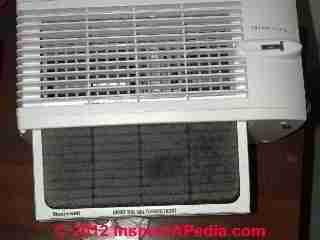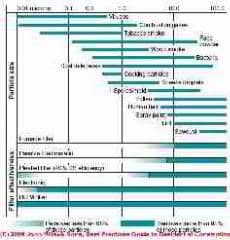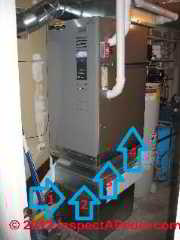 Indoor Air Filtering Strategies
Indoor Air Filtering Strategies
- POST a QUESTION or COMMENT about how best to filter indoor air to improve indoor air quality
Indoor air filtering & cleaning methods: this article explains choosing and using different types of air filters or air cleaners to improve indoor air quality in homes.
We include a table of the types of particles found in indoor air, particle sizes, and type of filter needed to remove them. We also include a quick guide to the common hazardous gases found in indoor air. We point out which filter types are effective for different indoor air particle or gas contaminants, and how to buy and use air cleaners.
InspectAPedia tolerates no conflicts of interest. We have no relationship with advertisers, products, or services discussed at this website.
Air Cleaning & Filtering Strategies to Improve Indoor Air Quality
 Our photo (left) illustrates a simple pull-out washable foam air conditioner filter used on a portable room air conditioning unit. As noted in Best Practices Guide to Residential Construction (Steve Bliss, J Wiley & Sons) :
Our photo (left) illustrates a simple pull-out washable foam air conditioner filter used on a portable room air conditioning unit. As noted in Best Practices Guide to Residential Construction (Steve Bliss, J Wiley & Sons) :
There are many types and sizes of air cleaners and filters on the market, both stand-alone units and those integrated with HVAC equipment. Different types of air cleaners work on different types of pollutants and none handles everything.
The effectiveness of a device depends on a number of factors including the type and efficiency of the filter, how much air flows through it, how well the polluted air reaches the filter, and how effectively the clean air is delivered to occupied areas. (Some small units tend to draw in the same air they just exhausted, creating a short circuit with little impact on the larger space).
Also, with electronic air cleaners, performance drops off rapidly if the filters are not kept clean.
Another limiting factor is that many allergies are linked to larger particles, such as pollen, house dust, animal dander, and some molds, that are more likely found settled on surfaces than suspended in the air. A high-efficiency vacuum is needed for these, not an air cleaner.
Particles vs. Gases in Indoor Air
Some filters are effective with particles, such as dust and pollen, and others are effective with gases, such as combustion fumes and formaldehyde. Certain pollutants such as tobacco smoke contain both gases and particles, so they require two types of filters for effective removal.
Particles in Indoor Air - Particulates, Health Effects, & Air Filter Efficiency Chart

Sometimes called “particulates,” these are small solid or liquid particles suspended in the air. They can be captured in mechanical or electrostatic filter elements. How many get captured depends on the size of the particle along with the type, size, and efficiency of the filter and the rate of airflow.
See the particle size and filter type efficiency chart at left.
Tiny respirable airborne particles, .01 to 5 microns in size, invisible to the naked eye, pose the greatest risk to health because they stay airborne for many hours, almost indefinitely when riding air currents, they move through a building much like a gas, passing through even very small openings where air leaks are present, and because they are breathed deeply into the lungs.
Larger inhalable airborne particles 10 microns and above, (more likely to be trapped in the nose) are more often irritants and allergens (such as pollen grains or insect fragments and fecal pellet fragments in dust).
HEPA filters provide the best filtering performance across all particle sizes. As a reference to size, the diameter of a typical human hair is 25 to 60 microns.
Best Practices Guide Source: reprinted in the original text cited above, with permission from Oikois.com (C) 1994 Iris Communications, Inc.
Respirable airborne particles. These are small, invisible particles, typically ranging in size from 0.5 to 2.5 microns (millionths of a meter) that can penetrate deep into the lungs and cause acute or chronic illnesses. Examples include asbestos, viruses, bacteria, and the particles in tobacco smoke.
Other sources include unvented kerosene and gas space heaters, woodstoves, fireplaces, poorly adjusted furnace flues, and cracked heat exchangers. Health effects vary with the type of particle, degree of exposure, and individual sensitivity, and range from eye and respiratory irritation to chronic diseases, such as cancer.
Inspirable airborne particles. Particles ranging in size from about 2.5 to 10 microns include dust, pollen, animal dander, and some mold spores. These can be inhaled, but they generally do not penetrate deeply into the lungs. They may cause allergic responses and other health problems in some individuals.
Visible dust found in indoor air. Most particles over 10 microns get trapped in the nose and upper airways and do not generally cause health problems.
- See CONTINUOUS BLOWER FAN OPERATION for a discussion of using the central air conditioning or heating blower and duct system combined with filters for reducing indoor dust and particle levels.
- For optimum HVAC or ventilation system air filter placement, design, and filtration alternatives on central heating and air conditioning systems,
see AIR FILTERS for HVAC SYSTEMS
and AIR FILTERS, OPTIMUM INDOOR where we discuss the best or most effective air filtering strategies including cascaded air filters in series (photo at left). - See DUCT SYSTEM DEFECTS for an extensive review of HVAC duct problems & solutions.
- See ENVIRONMENTAL HAZARDS - INSPECT, TEST, REMEDY for our full list of environmental hazard identification and remedy related to buildings
- see A QUICK GUIDE to Indoor Biological Pollutants for the types of particles that an indoor air quality ventilation system needs to remove
- For a complete guide to dealing with mold problems in buildings,
see MOLD ACTION GUIDE - WHAT TO DO ABOUT MOLD; - For septic or sewer backups and bacterial concerns, see Sewage backup.
- see Combustion Appliances as Sources of Indoor Air Contaminants for details about particles from heating appliances, fireplaces, woodstoves, or smoking.
- see Guide to Lead Exposure Hazards Indoors
Quick Guide to Gases as Contaminants & Hazards in Indoor Air
Gaseous pollutants include combustion gases and a huge array of organic chemicals that have been detected in homes. Gaseous organic compounds can originate indoors from combustion appliances, cigarette smoking, cleaning and personal hygiene products, or hobby materials, or can outgas from building materials, such as pressed wood products, paints, adhesives, and caulks. Others, such as auto emissions and pesticides, originate out of doors and are drawn into the home with outside air.
Health effects vary with type of pollutant, level of exposure, and individual sensitivity, and range from eye and respiratory irritation and allergic responses to cancer and other serious diseases affecting the respiratory, liver, cardiovascular, and nervous systems.
Gaseous pollutants can be removed from the air by passing them through special adsorbents, such as activated carbon, that adhere to the gas molecules.
Radon & Other Gas Hazards in Indoor Air
Radon is a radioactive gas that may enter a building from soil or groundwater. The gas breaks down into short-lived particles, which can get trapped in the lungs and cause cancer. Although some adsorbents can reduce radon gas levels and some high-efficiency filters can trap radon progeny, this has not been adequately tested and is not currently endorsed by the EPA as a radon mitigation method.
Also see A Guide to Reducing Exposure to Formaldehyde Hazards in Indoor Air
see Radon Hazards in buildings: health effects, measuring, remediation guide for details.
see Carpeting and Indoor Air Quality, Health Effects for carpet, carpet padding, adhesive outgassing.
VOCs as indoor gas contaminants are discussed at Guide to Sources & Remedies for Volatile Organic Compounds VOCs as Indoor Air Contaminants.
-- Adapted with permission from Best Practices Guide to Residential Construction (Steve Bliss, J Wiley & Sons) .
...
Continue reading at DIRTY AIR FILTER PROBLEMS or select a topic from the closely-related articles below, or see the complete ARTICLE INDEX.
Or see these
Recommended Articles
Suggested citation for this web page
AIR FILTERING STRATEGIES at InspectApedia.com - online encyclopedia of building & environmental inspection, testing, diagnosis, repair, & problem prevention advice.
Or see this
INDEX to RELATED ARTICLES: ARTICLE INDEX to BUILDING INDOOR AIR QUALITY IAQ
Or use the SEARCH BOX found below to Ask a Question or Search InspectApedia
Ask a Question or Search InspectApedia
Questions & answers or comments about how best to filter indoor air to improve indoor air quality.
Try the search box just below, or if you prefer, post a question or comment in the Comments box below and we will respond promptly.
Search the InspectApedia website
Note: appearance of your Comment below may be delayed: if your comment contains an image, photograph, web link, or text that looks to the software as if it might be a web link, your posting will appear after it has been approved by a moderator. Apologies for the delay.
Only one image can be added per comment but you can post as many comments, and therefore images, as you like.
You will not receive a notification when a response to your question has been posted.
Please bookmark this page to make it easy for you to check back for our response.
Our Comment Box is provided by Countable Web Productions countable.ca
Citations & References
In addition to any citations in the article above, a full list is available on request.
- Steve Bliss's Building Advisor at buildingadvisor.com helps homeowners & contractors plan & complete successful building & remodeling projects: buying land, site work, building design, cost estimating, materials & components, & project management through complete construction. Email: info@buildingadvisor.com
Steven Bliss served as editorial director and co-publisher of The Journal of Light Construction for 16 years and previously as building technology editor for Progressive Builder and Solar Age magazines. He worked in the building trades as a carpenter and design/build contractor for more than ten years and holds a masters degree from the Harvard Graduate School of Education. Excerpts from his recent book, Best Practices Guide to Residential Construction, Wiley (November 18, 2005) ISBN-10: 0471648361, ISBN-13: 978-0471648369, appear throughout this website, with permission and courtesy of Wiley & Sons. Best Practices Guide is available from the publisher, J. Wiley & Sons, and also at Amazon.com - Our recommended books about building & mechanical systems design, inspection, problem diagnosis, and repair, and about indoor environment and IAQ testing, diagnosis, and cleanup are at the InspectAPedia Bookstore. Also see our Book Reviews - InspectAPedia.
- In addition to citations & references found in this article, see the research citations given at the end of the related articles found at our suggested
CONTINUE READING or RECOMMENDED ARTICLES.
- Carson, Dunlop & Associates Ltd., 120 Carlton Street Suite 407, Toronto ON M5A 4K2. Tel: (416) 964-9415 1-800-268-7070 Email: info@carsondunlop.com. Alan Carson is a past president of ASHI, the American Society of Home Inspectors.
Thanks to Alan Carson and Bob Dunlop, for permission for InspectAPedia to use text excerpts from The HOME REFERENCE BOOK - the Encyclopedia of Homes and to use illustrations from The ILLUSTRATED HOME .
Carson Dunlop Associates provides extensive home inspection education and report writing material. In gratitude we provide links to tsome Carson Dunlop Associates products and services.


